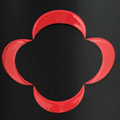Adega José de Sousa
by
Kathy Sullivan
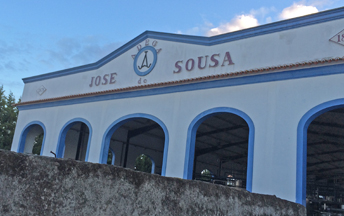 Summary: Visitors to Adega José de Sousa will quickly discover a combination of old and modern winemaking technology. The large clay pots located under arched ceilings are mesmerizing to behold. The José de Sousa brand was purchased by the José Maria da Fonseca winemaking company in the mid 1980s.
Summary: Visitors to Adega José de Sousa will quickly discover a combination of old and modern winemaking technology. The large clay pots located under arched ceilings are mesmerizing to behold. The José de Sousa brand was purchased by the José Maria da Fonseca winemaking company in the mid 1980s.
The winery offers an array of artifacts both inside and outside the buildings. In addition to old clay pots, outside one door was an aging horse drawn cart. In the vineyard, posts made of granite were seen. Inside artifacts included a large monolith and many clay pots and old wood casks.
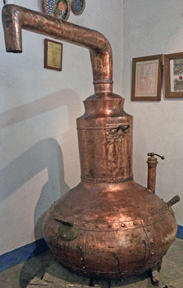 An old copper still was in one corner of the tasting room. Numerous old wine bottles were seen including one labeled Azinhaga Aguardente and dated 1875.
An old copper still was in one corner of the tasting room. Numerous old wine bottles were seen including one labeled Azinhaga Aguardente and dated 1875.
Winery
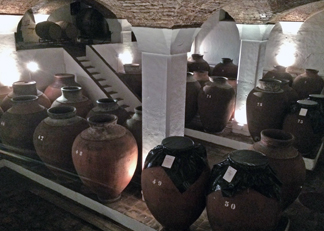 At José de Sousa winery, located in Reguengos de Monsaraz, we discovered wines produced in gleaming stainless steel tanks and the much more unusual red clay pots. In Portugal the clay pots are known as talhas. José de Sousa has 140 of these large clay pots. The clay pots are located on a lower level of the winery. This old 1877 cellar is the quiet environment for these talhas holding 1,200 liters, and standing on the floor. Lined up against walls and in straight rows they remind one of soldiers standing at attention and ready to march.
At José de Sousa winery, located in Reguengos de Monsaraz, we discovered wines produced in gleaming stainless steel tanks and the much more unusual red clay pots. In Portugal the clay pots are known as talhas. José de Sousa has 140 of these large clay pots. The clay pots are located on a lower level of the winery. This old 1877 cellar is the quiet environment for these talhas holding 1,200 liters, and standing on the floor. Lined up against walls and in straight rows they remind one of soldiers standing at attention and ready to march.
In Portugal this is considered the traditional way of using the clay pots for wine production and dates back to the time of the Romans. The clay pots are coated on the inside with a blend of a resin and wax to prevent the wine from seeping through the porous clay sides. The wine macerates inside the clay pots until February. The top of the fermenting wines are protected from oxidation by a coating of high quality olive oil. During fermentation talhas are sprayed with water to control the fermentation temperature inside the talhas.
Vineyards
The vineyards at José de Sousa consist of 70 hectares (173 acres). Grape varieties include Trincadeira, Aragonez and Grand Noir. The winery also sources grapes from other growers. Currently the winery produces 800,000 bottles of wine. All wines are from the Vinho Regional Alentejo region.
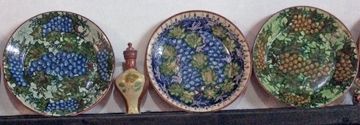 Tasting Room
Tasting Room
Back in the tasting room we tasted several of the José de Sousa wines while taking time to meander through the room to observe the displays of many old, dusty wine bottles. What a story some of these wine bottles might share! As we tasted and enjoyed the wines, I took note of the Portuguese decor which included a shelf of colorful plates.
José de Sousa Wines
Vinho Tinto 2016, Vinho Regional Alentejo was a blend of Grand Noir, Trincadeira and Aragonez. The 13.5% alcohol wine was a dark ruby to black color. There was an aroma of black fruit. This medium-bodied wine offered a taste of blueberry and black cherry. The wine had medium tannins. The finish was fruity with some spices.
The Mayor 2015, Vinho Regional Alentejo was also a blend of Grand Noir, Trincadeira and Aragonez. The 14% alcohol wine was a dark ruby to black color. The aroma included black fruit notes and violets. The taste was of blackberries, blueberries and violets. This full-bodied wine had bold tannins. The finish was of fruit with a bit of spice.
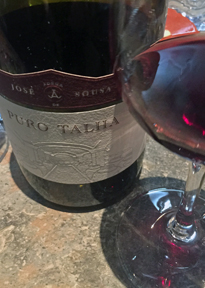 The Puro Talha 2015, Alentejo DOC was a blend of Grand Noir, Trincadeira, Aragonez and Moreto. The dark ruby to black colored wine had 12.5% alcohol. The aroma was of flowersl and black fruit. The taste offered blueberries, blackberries and violets. This was a full-bodied wine with medium to bold tannins. The finish was fruity. The wine bottle back label for the Puro Talha reads, “Since 1878 Casa Agricola José de Sousa Rosado Fernandes, in Reguengos de Monsaraz has been producing wine using traditional winemaking techniques. Keeping alive a tradition initiated by the Romans over 2000 years ago, the José de Sousa holds 114 clay amphorae, a fermentation method as rare as it is old. Puro Talha is the ultimate example of the recovery of this tradition. Vinification techniques: manual destemming using a Ripanço table, foot trodden, fermentation for 4 to 5 weeks, and then aged for 14 to 16 months in chestnut oak casks.”
The Puro Talha 2015, Alentejo DOC was a blend of Grand Noir, Trincadeira, Aragonez and Moreto. The dark ruby to black colored wine had 12.5% alcohol. The aroma was of flowersl and black fruit. The taste offered blueberries, blackberries and violets. This was a full-bodied wine with medium to bold tannins. The finish was fruity. The wine bottle back label for the Puro Talha reads, “Since 1878 Casa Agricola José de Sousa Rosado Fernandes, in Reguengos de Monsaraz has been producing wine using traditional winemaking techniques. Keeping alive a tradition initiated by the Romans over 2000 years ago, the José de Sousa holds 114 clay amphorae, a fermentation method as rare as it is old. Puro Talha is the ultimate example of the recovery of this tradition. Vinification techniques: manual destemming using a Ripanço table, foot trodden, fermentation for 4 to 5 weeks, and then aged for 14 to 16 months in chestnut oak casks.”
J wines are only produced in exceptional years such as 2007, 2011 and 2014. We were fortunate to be able to taste the 2014. J 2014, Vinho Regional Alentejo was a blend of Grand Noir, Touriga Franca and Touriga Nacional. This wine was a dark ruby color with 14% alcohol. The aroma offered notes of black fruits and perfume. The taste included blueberries, blackberries, perfume and spice. The wine had a medium to full body. There were bold tannins. The finish was fruity with spice and perfume on the aftertaste.
Our final wine to taste was the 1997 Moscatel Roxo, Peninsula de Setubal DOC, a dessert wine with 18% alcohol made from the purple Muscat grape. The color was a burnt orange. The aroma was of oranges and Muscat. The taste was sweet with orange notes. The finish offered a bit of heat with orange.
A visit to José de Sousa winery provides visitors with a unique view and taste of wines produced in clay pots.
José de Sousa
R. de Mourão 1, 7200
Reguengos de Monsaraz, Portugal
Article written April 2018.
Please support the following.
 |
||||
|
Portugal |
Spain and Portugal |
SmoothRed London, England, United Kingdom |
